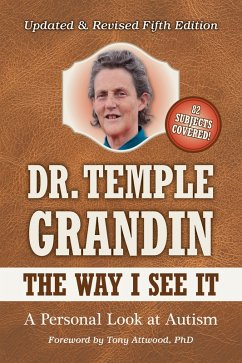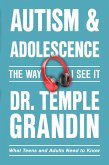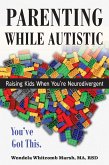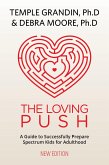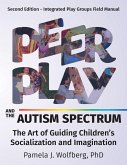

Alle Infos zum eBook verschenken

- Format: ePub
- Merkliste
- Auf die Merkliste
- Bewerten Bewerten
- Teilen
- Produkt teilen
- Produkterinnerung
- Produkterinnerung

Hier können Sie sich einloggen

Bitte loggen Sie sich zunächst in Ihr Kundenkonto ein oder registrieren Sie sich bei bücher.de, um das eBook-Abo tolino select nutzen zu können.
Dr. Temple Grandin gets to the REAL issues of autism¿the ones parents, teachers, and individuals on the spectrum face every day. Temple offers helpful dos and don'ts, practical strategies, and try-it-now tips, all based on her insider perspective and a great deal of research. These are just some of the specific topics she delves into: how and why people with autism think differently, economical early intervention programs that work, how sensory sensitivities affect learning, behaviors caused by a disability vs. just bad behaviors, teaching people with autism to live in an unpredictable world,…mehr
- Geräte: eReader
- ohne Kopierschutz
- eBook Hilfe
- Größe: 12.1MB
- FamilySharing(5)
![Autism and Adolescence (eBook, ePUB) Autism and Adolescence (eBook, ePUB)]() Temple GrandinAutism and Adolescence (eBook, ePUB)17,09 €
Temple GrandinAutism and Adolescence (eBook, ePUB)17,09 €![Autism and Us: Old As Time (eBook, ePUB) Autism and Us: Old As Time (eBook, ePUB)]() Eustacia CutlerAutism and Us: Old As Time (eBook, ePUB)19,99 €
Eustacia CutlerAutism and Us: Old As Time (eBook, ePUB)19,99 €![Autism Parent Handbook (eBook, ePUB) Autism Parent Handbook (eBook, ePUB)]() Raun MelmedAutism Parent Handbook (eBook, ePUB)10,99 €
Raun MelmedAutism Parent Handbook (eBook, ePUB)10,99 €![Life on the Bridge (eBook, ePUB) Life on the Bridge (eBook, ePUB)]() Kaelynn PartlowLife on the Bridge (eBook, ePUB)11,92 €
Kaelynn PartlowLife on the Bridge (eBook, ePUB)11,92 €![Parenting while Autistic (eBook, ePUB) Parenting while Autistic (eBook, ePUB)]() Wendela Whitcomb MarshParenting while Autistic (eBook, ePUB)19,99 €
Wendela Whitcomb MarshParenting while Autistic (eBook, ePUB)19,99 €![The Loving Push, 2nd Edition (eBook, ePUB) The Loving Push, 2nd Edition (eBook, ePUB)]() Temple GrandinThe Loving Push, 2nd Edition (eBook, ePUB)20,99 €
Temple GrandinThe Loving Push, 2nd Edition (eBook, ePUB)20,99 €![Peer Play and the Autism Spectrum (eBook, ePUB) Peer Play and the Autism Spectrum (eBook, ePUB)]() WolfbergPeer Play and the Autism Spectrum (eBook, ePUB)32,94 €
WolfbergPeer Play and the Autism Spectrum (eBook, ePUB)32,94 €-
-
-
Dieser Download kann aus rechtlichen Gründen nur mit Rechnungsadresse in A, B, BG, CY, CZ, D, DK, EW, E, FIN, F, GR, H, IRL, I, LT, L, LR, M, NL, PL, P, R, S, SLO, SK ausgeliefert werden.
- Produktdetails
- Verlag: Future Horizons
- Seitenzahl: 400
- Erscheinungstermin: 3. April 2020
- Englisch
- ISBN-13: 9781949177480
- Artikelnr.: 58686248
- Verlag: Future Horizons
- Seitenzahl: 400
- Erscheinungstermin: 3. April 2020
- Englisch
- ISBN-13: 9781949177480
- Artikelnr.: 58686248
- Herstellerkennzeichnung Die Herstellerinformationen sind derzeit nicht verfügbar.
Do Not Get Trapped by Labels
Economical Quality Programs for Young Children with ASD
Different Types of Thinking in Autism
Higher Expectations Yield Results
Teaching Turn Taking
What School Is Best for My Child with ASD?
Chapter 2: Teaching & Education
Finding a Child’s Area of Strength
Teaching How to Generalize
The Importance of Developing Talent
Teaching People with Autism/Asperger’s to Be More Flexible
Teaching Concepts to Children with Autism
Bottom-Up Thinking and Learning Rules
Laying the Foundation for Reading Comprehension
Motivating Students
Getting Kids Turned On to Reading
Too Much Video Gaming and Screen Time
Service Dogs and Autism
The Importance of Choices
The Importance of Practical Problem-Solving Skills
Learning to Do Assignments That Other People Appreciate
Learning Never Stops
Chapter 3: Sensory Issues
Sensory Problems Are Variable
Visual Processing Problems in Autism
Auditory Processing and Sound Over Sensitivity in Autism
Incorporating Sensory Methods into Your Autism Program
The Effect of Sensory and Perceptual Difficulties on Learning Patterns
Environmental Enrichment Therapy for Autism
Chapter 4: Understanding Nonverbal Autism
A Social Teenager Trapped Inside
You Asked Me!
Why Do Kids with Autism Stim?
Tito Lives in a World of Sensory Scrambling
Understanding the Mind of a Nonverbal Person with Autism
Solving Behavior Problems in Nonverbal Individuals with Autism
Whole-Task Teaching for Individuals with Severe Autism
Chapter 5: Behavior Issues
Disability versus Just Bad Behaviors
Innovative Methods for Handling Hitting, Biting, and Kicking in Adults with
Severe Autism
Rudeness is Inexcusable
The Need to Be Perfect
Autism & Religion: Teach Goodness
Chapter 6: Social Functioning
Insights into Autistic Social Problems
Learning Social Rules
Emotional Differences Among Individuals with Autism or Asperger’s
Healthy Self-Esteem
Four Cornerstones of Social Awareness
Questions about Connecticut Shooter Adam Lanza, Asperger’s Syndrome, and
SPD
Children with Autism Lack Joint Attention
Chapter 7: Medications & Biomedical Issues
Alternative versus Conventional Medicine
Hidden Medical Problems Can Cause Behavior Problems
Evaluating Treatments
Medication Usage: Risk versus Benefit Decisions
Medical Therapies
My Treatment for Ringing in the Ears
Chapter 8: Cognition & Brain Research
Lose the Social Skills, Gain Savant Skills?
People on the Spectrum Focus on Details
The Extreme Male Theory of Autism
Detect Babies at Risk for Developing Autism with Head Measurements
Thinking in Details
A Look Inside the Visual-Thinking Brain
Brain Cortex Structure Similar in Brilliant Scientists and Autism
The Role of Genetics and Environmental Factors in Causing Autism
Chapter 9: Adult Issues & Employment
Improving Time Management and Organizational Skills
Employment Advice: Tips for Getting and Holding a Job
Teens with ASD Must Learn Both Social and Work Skills to Keep Jobs
Happy People on the Autism Spectrum Have Satisfying Jobs or Hobbies
Inside or Outside? The Autism/Asperger’s Culture
Portfolios Can Open Job and College Opportunities
Going to College: Tips for People with Autism
Finding Mentors and Appropriate Colleges
Reasonable Accommodation for Individuals on the Autism Spectrum
Get Out and Experience Life!
Can My Adolescent Drive a Car?
Innovative Thinking Paves the Way for AS Career Success
The Link Between Autism Genetics and Genius
My Sense of Self-Identity
Do Not Get Trapped by Labels
Economical Quality Programs for Young Children with ASD
Different Types of Thinking in Autism
Higher Expectations Yield Results
Teaching Turn Taking
What School Is Best for My Child with ASD?
Chapter 2: Teaching & Education
Finding a Child’s Area of Strength
Teaching How to Generalize
The Importance of Developing Talent
Teaching People with Autism/Asperger’s to Be More Flexible
Teaching Concepts to Children with Autism
Bottom-Up Thinking and Learning Rules
Laying the Foundation for Reading Comprehension
Motivating Students
Getting Kids Turned On to Reading
Too Much Video Gaming and Screen Time
Service Dogs and Autism
The Importance of Choices
The Importance of Practical Problem-Solving Skills
Learning to Do Assignments That Other People Appreciate
Learning Never Stops
Chapter 3: Sensory Issues
Sensory Problems Are Variable
Visual Processing Problems in Autism
Auditory Processing and Sound Over Sensitivity in Autism
Incorporating Sensory Methods into Your Autism Program
The Effect of Sensory and Perceptual Difficulties on Learning Patterns
Environmental Enrichment Therapy for Autism
Chapter 4: Understanding Nonverbal Autism
A Social Teenager Trapped Inside
You Asked Me!
Why Do Kids with Autism Stim?
Tito Lives in a World of Sensory Scrambling
Understanding the Mind of a Nonverbal Person with Autism
Solving Behavior Problems in Nonverbal Individuals with Autism
Whole-Task Teaching for Individuals with Severe Autism
Chapter 5: Behavior Issues
Disability versus Just Bad Behaviors
Innovative Methods for Handling Hitting, Biting, and Kicking in Adults with
Severe Autism
Rudeness is Inexcusable
The Need to Be Perfect
Autism & Religion: Teach Goodness
Chapter 6: Social Functioning
Insights into Autistic Social Problems
Learning Social Rules
Emotional Differences Among Individuals with Autism or Asperger’s
Healthy Self-Esteem
Four Cornerstones of Social Awareness
Questions about Connecticut Shooter Adam Lanza, Asperger’s Syndrome, and
SPD
Children with Autism Lack Joint Attention
Chapter 7: Medications & Biomedical Issues
Alternative versus Conventional Medicine
Hidden Medical Problems Can Cause Behavior Problems
Evaluating Treatments
Medication Usage: Risk versus Benefit Decisions
Medical Therapies
My Treatment for Ringing in the Ears
Chapter 8: Cognition & Brain Research
Lose the Social Skills, Gain Savant Skills?
People on the Spectrum Focus on Details
The Extreme Male Theory of Autism
Detect Babies at Risk for Developing Autism with Head Measurements
Thinking in Details
A Look Inside the Visual-Thinking Brain
Brain Cortex Structure Similar in Brilliant Scientists and Autism
The Role of Genetics and Environmental Factors in Causing Autism
Chapter 9: Adult Issues & Employment
Improving Time Management and Organizational Skills
Employment Advice: Tips for Getting and Holding a Job
Teens with ASD Must Learn Both Social and Work Skills to Keep Jobs
Happy People on the Autism Spectrum Have Satisfying Jobs or Hobbies
Inside or Outside? The Autism/Asperger’s Culture
Portfolios Can Open Job and College Opportunities
Going to College: Tips for People with Autism
Finding Mentors and Appropriate Colleges
Reasonable Accommodation for Individuals on the Autism Spectrum
Get Out and Experience Life!
Can My Adolescent Drive a Car?
Innovative Thinking Paves the Way for AS Career Success
The Link Between Autism Genetics and Genius
My Sense of Self-Identity
